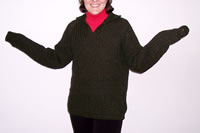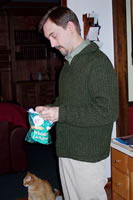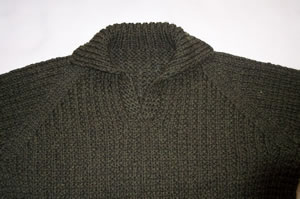Super Easy Seamless Knit Raglan Sweater Pattern
AKA: My Husband's Sweater. Knitting completed March 17, 2005. A crew neck version of this sweater is shown at "Ball Game Sweater".Lucia Liljegren, The Knitting Fiend: Get updates about my new patterns at my blog (The Knitting Fiend.)

When I finished Jim's sweater, he was in Daytona, on travel, so I modeled. We wear the same chest size sweater, but he's taller, and my arms and shoulder are shorter. He was home two days, before flitting off to Oklahoma; I had troubled getting him to pose. But, I managed-- see, the sleeves fit him.
Here is a list of features available with this generator:
- You can run it for free, but a donation is requested if you knit the sweater.
- As usual, enter the gauge for your yarn.
- Shape: Raglan pull over knit bottom to top.
- Polo neck, You can change this to a crew neck.
- Yarn Estimator: Broken Rib Stitch, Stockinette.
 Men's 38 displayed; you can change this to Women's
4-22; Men's 32-50. 18" doll and children's sizes. Custom setting lets you
modify the size to better suit you. Jim's sweater is a men's size 38,
but I then picked "custom", and shortened the sleeves and body.
Men's 38 displayed; you can change this to Women's
4-22; Men's 32-50. 18" doll and children's sizes. Custom setting lets you
modify the size to better suit you. Jim's sweater is a men's size 38,
but I then picked "custom", and shortened the sleeves and body.- Click this pop up pattern button to get your pattern. (I advise clicking it now. Really.)
- If the window doesn't pop up, scroll to the bottom and read the final instructions about pop-up windows.
- This pattern generator is a program that creates a pattern. If you want to customize for your size, your yarn or anything else, click the go-away box on the pattern window that popped up. Then, scroll down, and make changes. Then click any the pop-up window button you find on this page. opening. That will create your customized pattern.
- 9 skeins of Cascade 220, knit double stranded. I bought mine at Knitche!
in Downers Grove, Illinois. Cascade 200 has 220 yards per 100
grams and is considered a light worsted weight. When used double
stranded, it acts like a chunky or bulky yarn, and has 110 yards per
100 grams. I knit near 3.5 st/inch.
- Denise
circular needles with size 8 tips attached for main
stitch and size 6 for trim. This let me change the length of the
cable. It needs to be very long when you put all the stitches on
the yoke; smaller is better when you knit the top of the sleeves.
- Crystal Palace double pointed needles for the cuffs and bottom of the sleeves.
- Tapestry needle to sew the underarms and close the neck placket.
- A crochet hook to fix occasional mistakes.
 Blog pages discussing aspects of this sweater:
Blog pages discussing aspects of this sweater:- How to knit broken rib stitch.
- Yarn use for broken rib.
- Raglan 'seams'. Wide 4 stitch version I used. (Pattern instructions will create 2 stitch wide seams.)
- Placket detail and polo neck detail.
- Centering motifs.
- Using yarn double stranded (and probably save money).